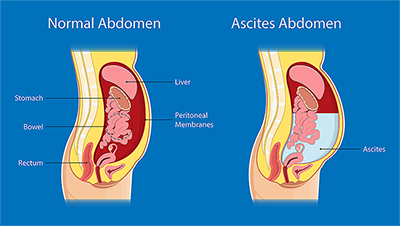International study finds that most people with cancer-related abdominal fluid obtain rapid benefit from paracentesis.

Ascites is the abnormal collection of fluid in the abdominal space and is a common complication of many advanced cancers. This additional fluid in the abdominal space can cause abdominal pain, a feeling of fullness, low appetite, tiredness, and constipation.
Paracentesis is the technical process of removing abdominal fluid and involves inserting a needle into the abdominal cavity to drain the fluid. However, this fluid may redevelop if cancer is still present. More recently, permanent drains have been developed to allow the drains to remain in the abdominal space, and for fluid to be drained when needed.
A recent international study, Paracentesis for cancer-related ascites in palliative care: An international, prospective cohort study, examined the benefits and harms experienced by patients with paracentesis while receiving palliative care in the ‘real-world’ setting.
The IMPACCT Rapid Program study found that patients who needed paracentesis were usually quite ill with a short remaining lifespan. Most patients had temporary paracentesis drains inserted with the help of ultrasound to locate the best place for insertion.

Paracentesis did improve one or more symptoms in most patients, and about half of patients experienced some benefits without any harm. About one-third of patients experienced harm, the most common being an ascitic leak, which is the leakage of the ascitic fluid, usually around the drain site. There were serious and fatal harms in less than 5 per cent of patients, including patients having bowel perforation, infection, and bleeding.
Some of the harms could have been minimised by ultrasound guidance but may not have been easily available in remote health settings. Other alternatives, such as bedside ultrasound machines, where a smaller, mobile ultrasound machine is utilised, could be considered in these settings.
While paracentesis does help most patients, determining the best timing for the procedure is challenging, especially for frail, ill patients with a short life expectancy. Balancing the benefits of the procedure and the harms and burdens must be discussed with patients and their families to help them make informed decisions.
Fewer patients had the insertion of permanent drains, and the numbers were too small to compare the outcomes of those with permanent and temporary drains. Our findings indicate that paracentesis should be performed using ultrasound guidance to minimise potential harm whenever possible.
More studies are needed to directly compare temporary and permanent drains and determine the best time for paracentesis.
The results of this study have been published in Palliative Medicine: https://pubmed.ncbi.nlm.nih.gov/36113139/

Dr Davinia Seah is a Conjoint Senior Lecturer in the School of Clinical Medicine at the University of New South Wales and a Palliative Care Staff Specialist at Sacred Heart Health Service. She is a PhD candidate at the University of Technology Sydney. Her thesis topic is ‘Health Service Utilisation at the End of Life’.

